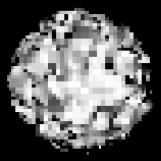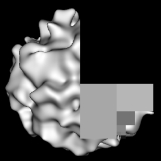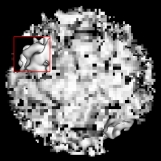Visualisation of Implicit Surfaces by Progressive Refinement
Manuel N. Gamito
Steve C. Maddock
The University of Sheffield
Visualising implicit surfaces with the ray casting method is a slow
procedure. The design cycle of a new implicit surface is, therefore,
fraught with long latency times as a user must wait for the surface to
be rendered before being able to decide what changes should be
introduced in the next iteration. In this paper, we present an attempt
at reducing the design cycle of an implicit surface modeler by
introducing a progressive refinement rendering approach to the
visualisation of implicit surfaces. This progressive refinement renderer
provides a quick previewing facility. It first displays a low quality
estimate of what the final rendering is going to be and, as the
computation progresses, increases the quality of this estimate at a
steady rate. The progressive refinement algorithm is based on the
adaptive subdivision of the viewing frustum into smaller cells. An
estimate for the variation of the implicit function inside each cell is
obtained with an affine arithmetic range estimation technique. Overall,
we show that our progressive refinement approach not only provides the
user with visual feedback as the rendering advances but is also capable
of completing the image faster than a conventional implicit surface
rendering algorithm based on ray casting.
This paper was presented at the GRAPP 2006
conference that was held in Set�bal, Portugal, between the 25 and the
28 of February, 2006. It was previously published as technical report CS-05-11 in the Department of Computer Science, The University of Sheffield. The GRAPP 2006 paper is available from the link below:
PDF format (234 K) (progressivegrapp.pdf)
The paper was later selected for publication in a Springer book,
containing the best papers from the GRAPP 2006 conference. The version
submitted for the book has been expanded to contain a more thorough
description of the affine arithmetic range estimation technique that we
use. The final paper is available from www.springerlink.com. A draft paper is available below:
PDF format (282 K) (progressivespringer.pdf)
We have implemented a different approach to progressive rendering of
implicit surfaces that uses Lipschitz bounds instead of affine
arithmetic bounds for estimating the variation of the surface. This
approach can only be undertaken for surfaces that are Lipschitz
continuous but this is not a very restrictive condition. The advantage
of using Lipschitz bounds is that they can be evaluated much more
quickly than affine arithmetic bounds, making the progressive renderer
more efficient. The final paper has been published in the Computers & Graphics journal and is available at www.sciencedirect.com.
A draft version is available from the link below:
PDF format (686 K) (progressivescag.pdf)
Some Animations from the Paper
The following animations illustrate the most important features of
our progressive refinement visualiser for implicit surfaces. The
progress bar that is shown in red at the bottom of the animations
indicates the percentage of pixels in the image that have reached their
final intensity values and that, therefore, need not be refined any
further. There is a large initial increase in this percentage value as
the background areas are quickly resolved by the previewer.
 |
This illustrates the typical
progression mode. The overall image quality improves quickly and the
final stages of refinement are concerned with resolving the small scale
features of the surface.
Quicktime MOV format (4.6M) (snap1.mov) |
 |
It is possible to have different
progression modes in the previewer. This animation shows a depth-first
progression mode where small image areas have higher priority over
larger ones.
Quicktime MOV format (2.5M) (snap2.mov) |
 |
With our previewer, it is possible to
define interactively rectangular Regions of Interest (ROI) as the
rendering progresses. Any parts of the implicit surface seen through a
ROI will be given priority during the refinement process. This animation
shows the use of several ROI's during a visualisation.
Quicktime MOV format (16.5M) (snap3.mov) |


